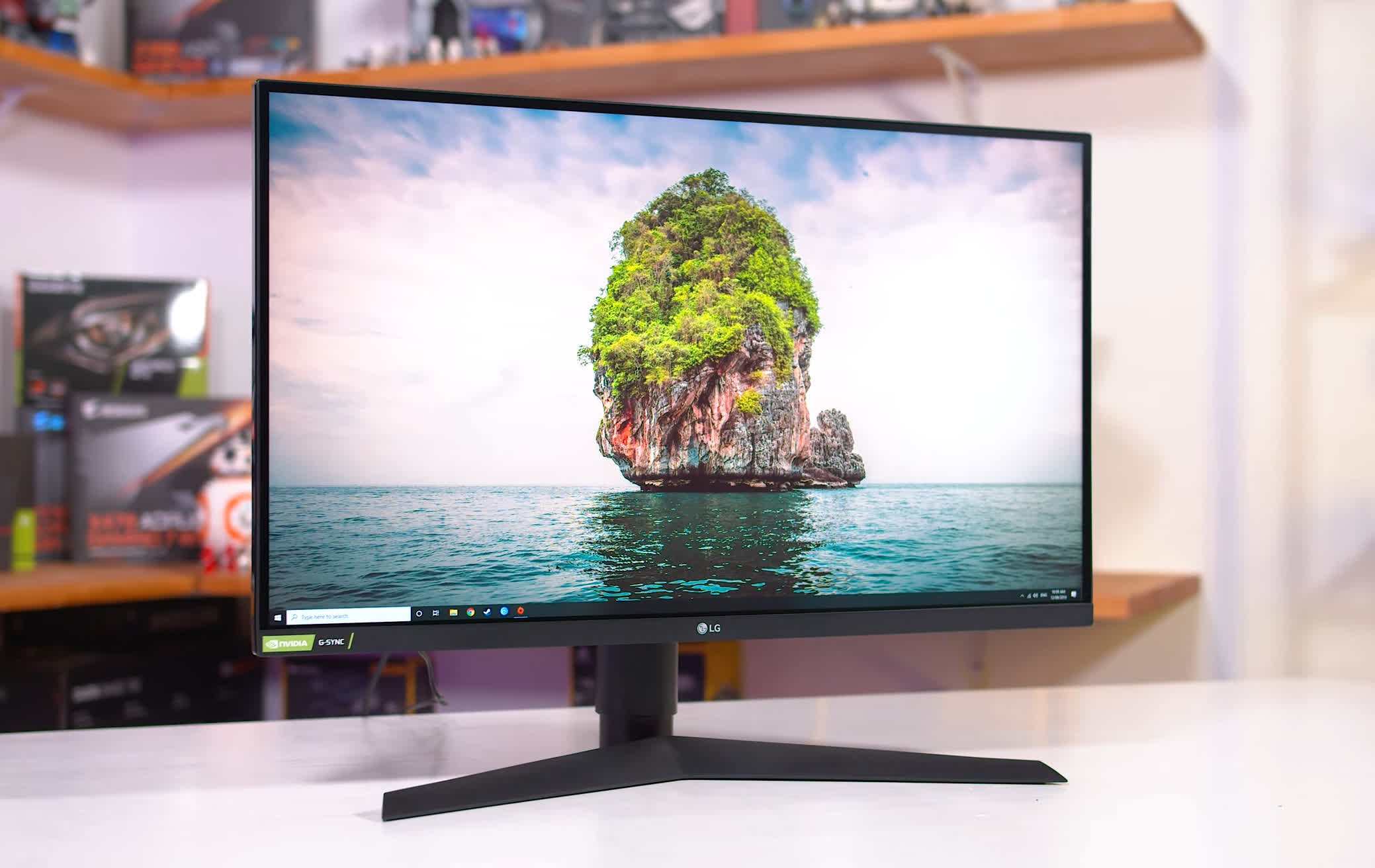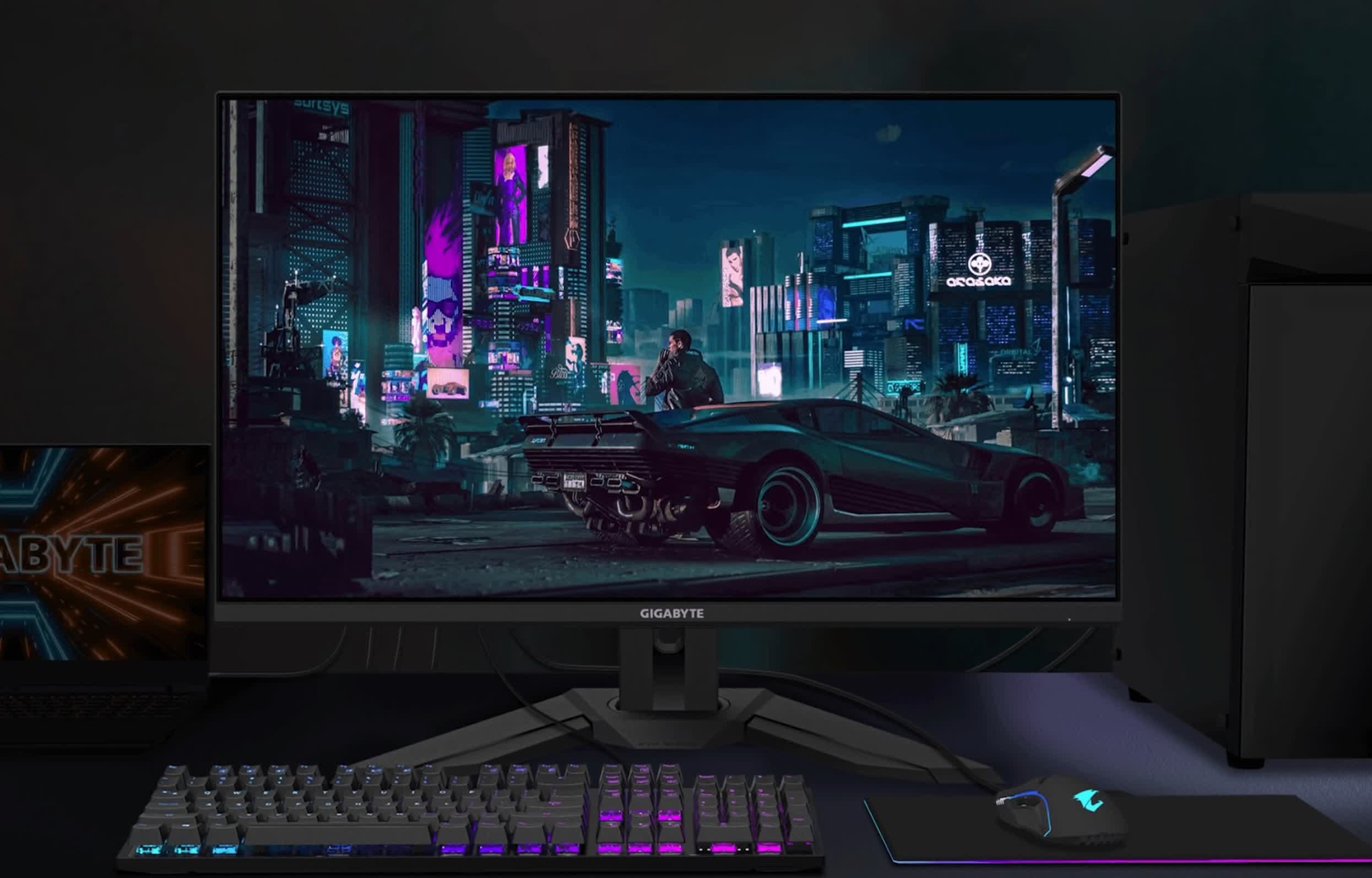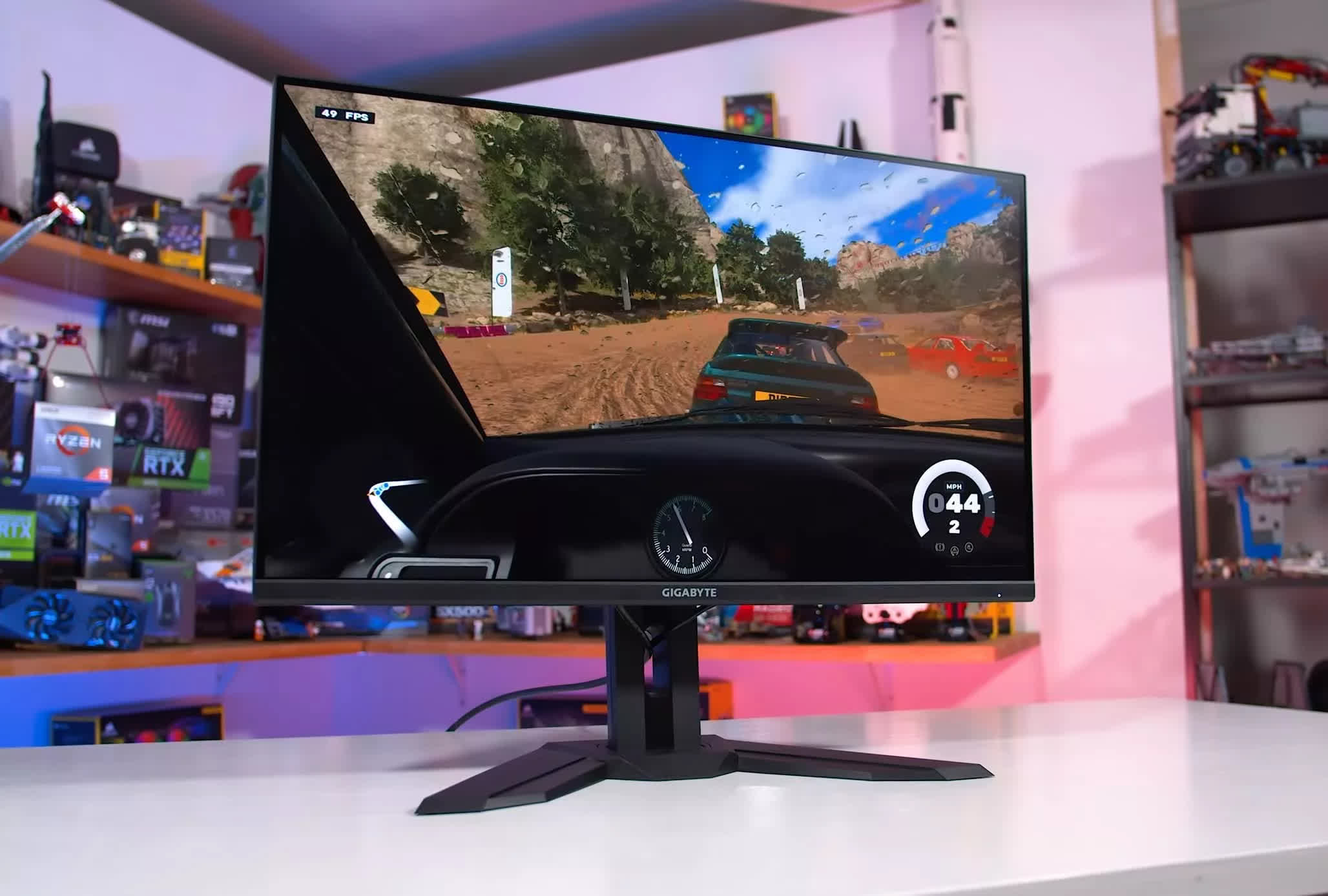See our latest update to this buying guide: The Best Gaming Monitors
Gaming monitors at 1440p remain the sweet spot for many PC gamers who don't need to spend a ton of money to play at high refresh rates. With new OLED options and pricing changes for some of our favorite gaming choices, it's time to update our 1440p monitor recommendations for early 2023.
We've split our recommendations in six categories covering a variety of 1440p options and configurations, so we're sure you'll be able to find something for you. As usual, we tend to discuss and recommend monitors we've personally tested and know to be excellent options, or monitors that are very similar to the ones we have tested. It's always worth going back and checking out the dedicated monitor reviews we produce for more in-depth thoughts on each product.
- Best Budget 1440p
- Premium 1440p @ 240Hz
- Best Value 1440p @ 240Hz
- Best 1440p @ 360Hz
- Best 32-Inch 1440p
- Best 1440p HDR
More Buying Guides:
- Best Gaming Monitors (including 4K and 1080p)
- Best HDR Gaming Monitors
- Best PC Monitors for Productivity
Best Budget 1440p
LG 27GL83A or MSI G274QPF-QD

For gamers on a budget, the 120Hz-180Hz zone remains the best category at 1440p, which are medium refresh rate options these days. Typically, if you want to get into PC gaming for the first time, or you want to upgrade from an older 1080p display, this category provides the best bang for buck and offers the most choices at $250 to $350. There are still lots of monitors priced above $350 in this segment but then we begin to encroach on higher refresh rate options, so we strongly recommend not to overspend if you are not getting any more performance.
Some of the options that we've previously recommended are out of stock and hard to find, such as the Gigabyte M27Q Pro / M27Q-P. That's still a great buy if you can find one for around $300, but because it's hard to find here are other good options.
Surprisingly, the best choice for budget 1440p shoppers right now is an older model, the LG 27GL83A. We've recommended various products from this series over the years, such as the 27GL850, 27GP850 and 27GP83B – for just $250, the 27GL83A is a standout choice that offers excellent value for gamers.
The LG GL83A is very similar to the 27GL850 we reviewed back in 2019, but now in 2023 it's half the price and lacks the wide color gamut support of that monitor. It's also less of a standout than it was back then, we've seen many other monitors launch with similar hardware capabilities over the last few years, but at this new low price it's a very competitive product that we can recommend.
The strength of the LG 27GL83A lies on its speed and response times. This is a 27-inch 2560 x 1440 IPS display at a maximum refresh rate of 144Hz with VRR support. It typically offers a 5-6ms response time experience with low overshoot, which leads to a clear and artifact-free experience while gaming. It's right up there among the better choices in the sub $350 category as the LCD panel used has aged quite well. There's also low input lag, decent color performance and wide viewing angles.
The main downside of this LG IPS series is the contrast ratio, which is low and doesn't deliver impressive blacks. This specific variant also lacks a wide color gamut if that's something that you're interested in. But despite the contrast ratio we'd definitely prefer this monitor over a VA LCD at this price point, as they all typically feature ugly dark level smearing and curved panels, which we dislike compared to flat screens at this size.
Another Great Option
An upgrade pick is the MSI G274QPF-QD which is readily available for $330. This monitor is very similar to the Gigabyte M27Q Pro, except with a wide quantum-dot enhanced color gamut. This offers a point of difference to the 27GL83A; if you need a wider color gamut for creative tasks, or just like the extra saturation, this MSI display provides that along with decent color modes for sRGB, P3 and Adobe RGB. Its contrast ratio is also about 20% higher than the LG model, though response time performance isn't as good, so it's balanced more towards color than speed. At $330 it's not as great value as the LG, but it does offer a few advantages.
Best Premium 1440p @ 240Hz
Asus ROG Swift OLED PG27AQDM 27"

The best 1440p 240Hz monitor on the market is also one of the overall best 1440p displays and perhaps a contender for best monitor, period. It's the Asus ROG Swift OLED PG27AQDM, which brings with it a 27-inch 2560 x 1440 WOLED panel at a 240Hz refresh rate. This is an excellent high-end display, offering elite speed for competitive gamers and stunning HDR visuals for single player gamers in the one package.
The key reason to purchase an OLED monitor is for its HDR performance, and this Asus variant delivers noticeably higher brightness compared to the LG equivalent, the 27GR95QE. We see up to 900 nits of brightness in HDR content that when combined with the deep zero-level blacks of OLED, results in a super high contrast ratio, and per pixel dimming – this is a stunning HDR experience that looks fantastic while gaming. It's also capable of 250 nits of brightness for SDR content, much higher than other WOLED monitors we've tested.
With a high 240Hz refresh rate, the PG27AQDM is also capable of elite motion clarity. While gaming at 240Hz, it looks super clear and smooth, thanks to lightning fast response times. A 240Hz OLED is roughly equivalent to a 360Hz LCD in clarity, and OLEDs are able to deliver the same response performance at all refresh rates, leading to an artifact-free experience even when gaming at, say, 100Hz. This gives this display a rare combination of motion clarity and visual quality that you don't get from other products. In fact, this is one of the few monitors that can deliver a top tier experience in both HDR and motion in the same package.
Other benefits from this OLED include excellent viewing angles, great build quality with no obvious fan noise, a nice wide color gamut, and of course adaptive sync support. It is expensive at $1,000, but not overly so considering true HDR monitors with equivalent performance just a few years ago were closer to $2,000+.
On the shortcomings, an OLED like this is not well suited to productivity work or desktop apps due to its non-standard subpixel layout, which causes text rendering issues; as well as its risk of permanent burn in while viewing static content. Neither of these are of big concern while gaming or watching videos, but right now OLED isn't well suited to desktop tasks.
If we had to make a list of the favorite monitors we've reviewed this year so far, we'd probably have this one right near the top of that list.
Best Value 1440p @ 240Hz
Gigabyte M27Q-X 27"

Naturally, a lot of gamers might be interested in a 240Hz 1440p gaming monitor without spending a thousand bucks for the Asus OLED model. That's where our value choice for these specs comes in.
The Gigabyte M27Q-X is an excellent 27-inch 1440p 240Hz IPS gaming monitor priced around $430. It's one of the cheapest and best value ways to access 240Hz at a decent resolution – it's also more affordable than other similar options that deliver roughly the same performance. Be warned that the M27Q-X and close competitors are quite difficult to find in stock right now, but hopefully this is just a short term availability issue and the M27Q-X will be restocked, because it's an excellent product that we can highly recommend.
Even without a good 1440p 240Hz LCD priced below $450, it's hard to recommend any of the typically $600+ options. If you can't get the M27Q-X, we would just wait until it comes back in stock, or grab something in a different category.
The M27Q-X offers a fast response time experience on par with today's good quality IPS LCD panels. When you combine response speed with a high refresh rate, you get great motion clarity making this monitor highly suitable to competitive multiplayer gaming, but with the versatility of a decent resolution for other types of games as well. The only downside here being the lack of a single overdrive mode experience, which its more expensive competitors can offer, depending on the model.
Gigabyte also provides good color quality including a nice wide color gamut, decent uniformity, great viewing angles and a respectable job of factory calibration as far as gaming monitors go. We always like when a monitor delivers a good balance of performance across all categories and that's what the M27Q X provides.
Best 1440p 360Hz Monitor
Asus ROG Swift PG27AQN 27"

If you're after the ultimate high performance 1440p gaming monitor for competitive multiplayer, that's the Asus ROG Swift PG27AQN. It's currently the only 1440p 360Hz display on the market, packing a 27-inch IPS panel with some of the fastest response times we've ever measured on an LCD. It is a high-end option, coming in at $1,050, so it's aimed at hardcore esports gamers, but it does deliver impressive performance.
The main advantage to getting a 360Hz display like this is motion clarity and input lag. When gaming at 360Hz, you'll get the clearest experience of any 1440p monitor, just slightly edging out the 240Hz OLED we talked about earlier. This level of clarity and smoothness makes it easier to spot and target enemies, without sacrificing on resolution.
Previously to access this refresh rate, you'd have needed a 1080p display, which isn't the best these days. With the PG27AQN you get a higher 1440p resolution, delivering a sharper image and additional versatility as this is also a great monitor for single player games thanks to its pixel density and excellent IPS color quality.
Lower input latency is a given at 360Hz, this is a very responsive display – the fastest we've experienced at 1440p. It has adaptive sync support with great performance, especially above 100Hz.
Asus also delivers outstanding color calibration, which is often not the case with other competitive-focused gaming monitors; this strengthens the versatility of this display and its usability for all types of gaming.
The only major downside to the ROG PG27AQN aside from its high price tag are the lack of proper HDR support and lack of backlight strobing. This is a product focused towards competitive gamers, so we suspect people who are more primarily interested in a single player experience will be better off with the Asus 240Hz OLED at a similar price. Not having backlight strobing is a bit of an unusual omission, with the very best 1080p strobed displays able to outperform this 360Hz unit in terms of clarity. But at 360Hz we still think this monitor is well above average in motion performance and currently there are no 1440p options that offer this refresh rate with strobing.
Best 32-Inch 1440p
Gigabyte M32Q or MSI Optix MPG321QRF-QD

In the categories discussed so far, the focus has largely been on 27-inch 1440p monitors, which is where the best performance products are today. But for some gamers, 27 inches is just too small and that's where the 32-inch display format comes into play.
The Gigabyte M32Q continues to be a standout option for 32-inch 1440p buyers, offering that panel size with a 170Hz refresh rate and IPS technology for just $400. The Gigabyte is a well balanced product, it does not offer class-leading performance, but there are no huge weak points either. At this sort of price point, we don't think you necessarily need the outright fastest panel or the widest color gamut, just something that is capable in all categories, and the M32Q performs very well.
Motion performance is in line with most modern IPS gaming panels, especially when looking at cumulative deviation that gives us an idea of the balance between response times and overshoot. Its 170Hz refresh rate is decent, low input lag of course, and Gigabyte complements this with a backlight strobing feature that works in conjunction with adaptive sync.
For color performance, we're getting the usual benefits of IPS – a flat panel with excellent viewing angles, a wide but not that wide gamut and an above average IPS contrast ratio.
We wouldn't necessarily describe this as an ideal monitor for content creation, but it has a level of versatility that's well suited for playing games and watching videos.
Also worth considering is the MSI Optix MPG321QRF-QD, which we've seen on sale recently for as low as $380.
While we haven't tested this display, the 321QRF uses a better panel featuring quantum-dot technology, leading to a wider color gamut. If that's something you need, especially for creative work, the MSI alternative might be worth exploring, especially for the price. We've seen this kind of panel previously and been impressed with the performance in other areas like response times, so we suspect it will be a good buy, but unfortunately we haven't tested it as extensively as the M32Q, so it is a bit harder to recommend.
Best 1440p HDR Monitor
Asus ROG Swift OLED PG27AQDM 27"

If you're looking for the best 1440p HDR gaming monitor, there's only one standout choice: once again, it's the Asus ROG Swift OLED PG27AQDM. If you missed the premium 1440p 240Hz category, go back and check out that section as it covers everything you need to know about this Asus champion.
The ROG Swift OLED PG27AQDM sports a 27-inch 2560 x 1440 WOLED panel at a 240Hz refresh rate. This is an excellent high-end display, offering elite speed for competitive gamers and stunning HDR visuals in the one package.
In the HDR category specifically, there aren't a ton of other suitable choices. There is the LG 27GR95QE which is the LG version of this Asus model, but with much lower brightness at a similar price point, so it's hard to recommend.
We've also tested the Cooler Master GP27Q which is a 27-inch 1440p 165Hz LCD with 576-zone local dimming and true HDR support. It's a lot cheaper than the Asus, but has dealbreaker issues with flickering that make it hard to recommend.








